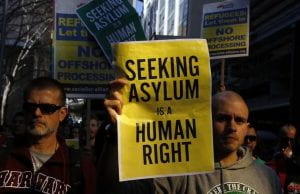Critical Global Fictions and Pakistani Literature
Learn more about: Mohsin Hamid’s Global Fiction.
In this journal, Joseph Darda argues that Mohsin Hamid’s novel, The Reluctant Fundamentalist is a critical global fiction. Darda explains that “global literature theories, in short, emphasizes the ways in which literature might introduce and fortify a global imaginary.” Likewise, Exit West also serves this function. Darda concludes that “The Reluctant Fundamentalist, as a work of global fiction, offers a counterstatement to one of the most established ways of understanding the post-9/11 era: Giorgio Agambens account of ‘bare life.'”
Darda, Joseph. “Precarious World: Rethinking Global Fiction in Mohsin Hamid’s ‘The Reluctant Fundamentalist.'” Mosaic: An Interdisciplinary Critical Journal, vol. 47, no. 3, 2014, pp. 107–122. JSTOR, www.jstor.org/stable/44029864.
.
Learn more about: Muslim Narratives.
In “Islam in the Writing Process,” Robin Yassin-Kassab confidently argues that Islam counts as a narrative civilization. He captures how he combats stereotypes of Islamic lifestyles in his novels. Later while exploring successful Islamic narratives, Yassin-Kassab concludes, “Mohsin Hamid’s The Reluctant Fundamentalist is perhaps the most successful recent novel born out of a desire for dialogue post-9/11. It is in fact staged around a dialogue between a Pakistani Muslim and an American tourist and it efficiently calls into question the notion of ‘fundamentalist.'”
Yassin-Kassab, Robin. “Islam in the Writing Processs.” Religion & Literature, vol. 43, no. 1, 2011, pp. 139–144. JSTOR, www.jstor.org/stable/23049361.
Learn more about: Contemporary Pakistani Writers.
“Pakistani writing is like a new fast bowler on the scene,” the authors, Namita Gokhale and Malashri Lal, recount in “South Asian Literature: Beyond Borders, Across Boundaries.” They assert Mohsin Hamid is part of new writers generation in Pakistani’s current literary “liberation.” Previously, Pakistan’s militant government censored authors speech with politically motivated content restrictions. Gokhale and Lal maintain that present-day Pakistani literature embodies a “finer understanding of a nuance past.”
Gokhale, Namita, and Malashri Lal. “South Asian Literatures: Beyond Borders, Across Boundaries.” India International Centre Quarterly, vol. 41, no. 3/4, 2014, pp. 236–248. JSTOR, www.jstor.org/stable/24390792.
Migration and Social Mobility
Learn more about: The Human Rights Approach to Migration.
Mohsin Hamid calls restrictive immigration practices a human rights violation. In “Theoretical Approaches to Human Smuggling,” Theodore Baird details the Human Rights approach to migration. “The difficult and dangerous lengths to which individuals go scaling state borders to migrate have raised serious questions about the moral, legal, and normative responses both state and non-state actors are obliged to consider.” He suggests that international Human Rights declarations, as well as agreements at the 1959 Geneva Convention, imply “that the smuggling of refugees is not illegal, but a fundamental component of international refugee law, which is compromised by the Palermo Protocols.”
Baird, Theodore. Theoretical Approaches to Human Smuggling. Danish Institute for International Studies, 2013, www.jstor.org/stable/resrep13470.
.
Learn more about: Global Displacement in the 21st Century.
Nadia and Saeed live in a seemingly far-fetched universe where eventually everyone is considered a migrant. Roderick Parkes predicts an unprecedented rise of displaced persons soon in his article, “Three sets of migration drivers.” “People who settle down are supposed to be the lucky ones. But in fact they are increasingly vulnerable. Climate scientists predict that environmental changes will displace a massive 200 million people by 2050 – a challenge to territorial order worldwide. But there is a deeper challenge too: climate change will trap far greater populations, hitting poor workers in sprawling coastal cities like Guangzhou, Ho Chi Minh City, Abidjan or Mumbai who cannot afford to flee.”
Parkes, Roderick. Three Sets of Migration Drivers. European Union Institute for Security Studies (EUISS), 2016, pp. 23–40, People on the Move: The New Global (Dis)order, www.jstor.org/stable/resrep07027.7.
Learn more about: The Migration Divide.
In “Migration and social mobility in Burkina Faso: historical perspectives on the migration divide,” Anne S. Olsen examines the historical role migration has played in increasing social mobility. Olsen dives deep into the movement within Africa, but her overarching theme relates to the type of migration explored in Exit West where migrants traveled to countries in the global North and South to escape atrocities in their homelands. According to Olsen, the migration divide “alludes to a difference between those who can and cannot migrate.” However, she “suggests that the migration divide should include the difference between intercontinental and intra-African migrants, since these two forms of migration throw up great disparities in the social mobility they confer.”
Olsen, Anne Sofie Westh. Migration and Social Mobility in Burkina Faso: Historical Perspectives on the Migration Divide. Danish Institute for International Studies, 2014, www.jstor.org/stable/resrep13406.
Hunter Southall ’19




